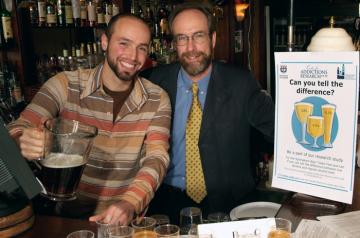The battle of the beers

When it comes to drinking, many young males can’t tell the difference between low-alcohol and regular strength beer.
That’s according to a study by UVic’s Centre for Addictions Research (CARBC). In fact, the study participants enjoyed themselves regardless of how much alcohol they consumed. The findings not only boost the case for taxing drinks on their alcohol content, but they make it clear that drinkers don’t have to get tipsy to have a good time.
CARBC research assistant and UVic graduate student Dave Segal (child and youth care) asked 34 young male volunteers to drink, eat pizza and play dominos in a pub-like setting while drinking unmarked low-alcohol beer (3.8 per cent) and regular strength beer (5.3 per cent). He found that about half of them could not distinguish between the two strengths of beer. As well, they reported no differences in how much they enjoyed themselves or their perceived intoxication. There was, however, a small difference in terms of preferring the taste of the 5.3-per-cent beer.
Currently, beers with less than 4 per cent alcohol occupy only 0.2 per cent of the BC beer market. And many low-alcohol content beers and coolers sold in BC liquor stores are more expensive than beverages with regular and even high alcohol content.
CARBC is asking the BC government to modify alcohol pricing policies so that drink prices reflect alcohol content. The reasoning behind the request is that if low-alcohol beverages were cheaper than high-alcohol drinks people would buy the less potent beverages. The findings of the Alcohol Harm Reduction Study support the centre’s proposal.
“We recommend these findings be used in devising alcohol taxation policy and other strategies that might create incentives for the manufacture, marketing and consumption of low-alcohol alternatives,” says Segal. “Following the experience of such incentives being introduced in Australia over two decades ago, such an initiative would provide the impetus for brewers to create a broader range of higher quality and better tasting varieties of low-alcohol beer.”
“New data indicate that there is a growing problem with alcohol in BC and in the nation as a whole,” remarks CARBC Director Dr. Tim Stockwell. “Increased consumption of alcohol has led to increases in cancers, liver diseases, road trauma, violence, birth defects and a host of other causes of death, injury and illness.”
Finance Minister Carole Taylor is quoted in the Victoria Times Colonist as saying that the tax proposal is one of thousands of recommendations she is reviewing for the upcoming budget. However, she notes that while it seems logical from a community or health perspective, it would be “extremely complicated” to write into tax legislation policy. She compares the logistics to taxing junk food based on its sugar or fat content.
The study took place between August and October 2006 and was supervised and funded by CARBC. The lower alcohol beer was donated by Spinnakers Gastro Brewpub and GuestHouses—Canada’s oldest brewpub and one of the few Canadian microbreweries that makes a lower alcohol beer. Spinnakers owner Paul Hadfield, in support of CARBC’s position, has also committed to lowering the price of his low-alcohol products in the very near future.
More information visit www.carbc.ca/ or www.AODmonitoring.ca. CARBC is a UVic research centre in partnership with UBC, UNBC, SFU and Thompson Rivers University.

